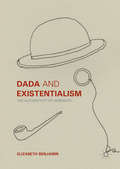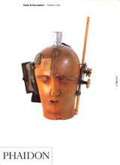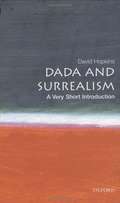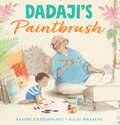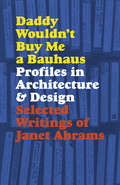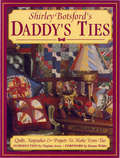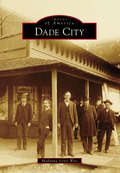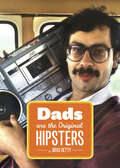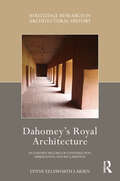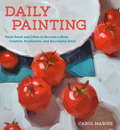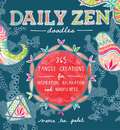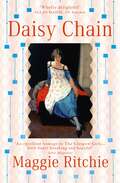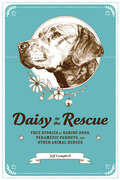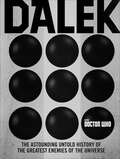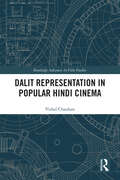- Table View
- List View
Dada and Existentialism: The Authenticity of Ambiguity
by Elizabeth BenjaminOfferingnew critical approaches to Dada as quintessential part of theAvant-Garde, Dada and Existentialism: the Authenticity of Ambiguity reassessesthe movement as a form of (proto-) Existentialist philosophy. Dada isoften dismissed as an anti-art movement with a merely destructive theoreticalimpetus. French Existentialism is often condemned for its perceived quietistimplications. However, closer analysis reveals a preoccupation with philosophyin the former and with art in the latter. Moreover, neither was nonsensical ormeaningless; both reveal a rich individualist ethics aimed at the ameliorationof the individual and society. The first major comparative study of Dada andExistentialism, this text contributes new perspectives on Dada as movement,historical legacy, and field of study. Analysing Dada works throughExistentialist literature across the themes of choice, alienation,responsibility, freedom and truth, the text posits that Dada and Existentialismboth advocate the creation of a self that aims for authenticity throughambiguity.
Dada and Its Later Manifestations in the Geographic Margins: Israel, Romania, Poland, and North America (Routledge Research in Art History)
by Ronit Milano Raya Zommer-Tal Noam GonnenThis volume focuses on the unstudied geographic margins of Dada, delving into the roots of Dada in Israel, Romania, Poland, and North America.Contributors consider some of the practices and experiments that were conceived a century ago, surfaced in art throughout the twentieth century, and are still relevant today. Unearthing its Israeli origins, examining Dadaist expressions in Poland, and shedding light on overlooked facets of Dadaist art in Romania and North America, the authors cast a spotlight on the less-explored geographical peripheries of Dada. The book is organized around four thematic trajectories—space, language, materiality, and reception—which are dissected through the lens of micro-histories. Recognizing the continuing validity of questions raised by Dadaist artists, this volume argues that Dada persists as an ongoing endeavor—a continual reexamination of the fundamental tenets of art and its ever-evolving potential manifestations.The book will be of interest to scholars working in art history, modernism, and history of the twentieth and twenty-first centuries.
Dada and Surrealism (Art and Ideas Ser.)
by Matthew Gale Etienne Menanteau Dagmar Welle-SkittDada and Surrealism were two revolutionary art movements which emerged in response to the events and ideas of the early twentieth century. Dada, characterized by found objects and works made according to the laws of chance, was anarchic and anti-art. In part a reaction to the senseless destruction of World War I, it questioned all accepted values. Surrealism, in contrast, was a more defined movement which evolved in the 1920s as artists and writers took up Freud's concept of the unconscious to undermine traditional conventions. By use of such techniques as automatism, artists sought to represent in concrete terms the imagery of dream and fantasy. In this clear and lively account, Matthew Gale explores the work of a wide range of artists - from Marcel Duchamp and Raoul Hausmann to Max Ernst, René Magritte and Salvador Dali - and uses paintings, collages, sculptures, assemblages, photographs, photomontages, film stills and graphics to illustrate the rich variety of Dada and Surrealist art. This essential introductory book is the first to reproduce many of these works in colour.
Dada and Surrealism: A Very Short Introduction
by David HopkinsThe avantgarde movements of Dada and Surrealism continue to have a huge influence on cultural practice, especially in contemporary art, with its obsession with sexuality, fetishism, and shock tactics. In this new treatment of the subject, Hopkins focuses on the many debates surrounding these movements: the Marquis de Sade's Surrealist deification, issues of quality (How good is Cali?), the idea of the "readymade," attitudes towards the city, the impact of Freud, attitudes to women, fetishism, and primitivism. The international nature of these movements is examined, covering the cities of Zurich, New York, Berlin, Cologne, Barcelona, Paris, London, and recently discovered examples in Eastern Europe. Hopkins explores the huge range of media employed by both Dada and Surrealism (collage, painting, found objects, performance art, photography, film), while at the same time establishing the aesthetic differences between the movements. He also examines the Dadaist obsession with the body-as-mechanism in relation to the Surrealists' return to the fetishized/eroticized body.
Dada: Art and Anti-Art (World of Art)
by Hans Richter David Britt<p>‘Where and how Dada began is almost as difficult to determine as Homer’s birthplace’, writes Hans Richter, the artist and film-maker closely associated with this radical and transforming movement from its earliest days. Here he records and traces Dada’s history, from its inception in about 1916 in wartime Zurich, to its collapse in Paris in 1922 when many of its members were to join the Surrealist movement, down to the present day when its spirit re-emerged first in the 1960s with, for example, Pop Art. <p>This absorbing eye witness narrative is greatly enlivened by extensive use of Dada documents, illustrations and a variety of texts by fellow Dadaists. It is a unique document of the movement, whether in Zurich, Berlin, Hanover, Paris or New York. The complex relationships and contributions of, among others, Hugo Ball, Tristan Tzara, Picabia, Arp, Schwitters, Hausmann, Duchamp, Ernst and Man Ray, are vividly brought to life. </p>
Dadaji's Paintbrush
by Rashmi SirdeshpandeOnce, in a tiny village in India, there was a young boy who loved to paint. He lived with his grandfather, who taught him to paint with his fingers, to make paints from marigolds and brushes made from jasmine flowers. Sometimes, the village children would watch them painting together, and the boy's grandfather would invite them to join in.They didn't have much, but they had each other.After his grandfather dies, the boy notices a little box wrapped in string with a note that read: "From Dadaji, with love," with his grandfather's best paintbrush tucked away inside. But he feels he will never want to paint again.Will the boy overcome his grief and find joy in painting and his dadaji's memory again?From Rashmi Sirdeshpande and Ruchi Mhasane comes a lushly illustrated tale of love, art, and family.
Daddy Calls Me Man
by Angela Johnson Rhonda MitchellIn four vibrant verses a young boy revels in the everyday pleasures of growing up in a family of fine artists. A still life of shoes inspires Noah to measure his own little ones against the big ones of his father. The whirl of an abstract painting encourages him to spin with his older sister. The moon outside his window is the same one that glows on his mother's canvas. But the subject that brings out the best in Noah -- and inspires his daddy to call him a man -- has her crib right there in his parents' studio. This book is a celebration of art and an exaltation of family.
Daddy Wouldn't Buy Me a Bauhaus: Profiles in Architecture and Design
by Janet AbramsDaddy Wouldn't Buy Me a Bauhaus collects the unparalleled writings of legendary British wordsmith Janet Abrams for the first time. From pivotal figures in international modernism to the pioneers of digital medium, Abrams explored the ideas, theories, and emotions that fueled their work.The book's twenty-six profiles, written in Abrams's signature, personal, often hilarious style, include Reyner Banham, Berthold Lubetkin, Philip Johnson, Paul Rand, Phyllis Lambert, Frank Gehry, Rem Koolhaas, Muriel Cooper, April Greiman, and Michael Bloomberg. Many of the profiles are back in print for the first time, having originally appeared in Blueprint, I.D. magazine, the Independent, and in books and catalogs from the 1980s through the early 2000s. A foreword by Blueprint's founding editor, Deyan Sudjic, and new reflections by Abrams set the stage.
Daddy's Ties
by Shirley BotsfordDo you have a bag of men's ties stashed away somewhere, just waiting for a good project idea? You can stop wondering what to do with those ties that your dad or husband no longer wears. Use them to make pillows, lamp shades, wall quilts or art-to-wear. Create new treasures from old ties that are probably the same ones that you have given as gifts on Father's Day, birthdays and Christmas. Shirley Botsford's glorious book is packed with over 30 functional and keepsake projects. Included are full-size patterns, step-by-step instructions and illustrations, plus inspiration, ideas, tips and techniques to create even more.
Dade City
by Madonna Jervis WiseDade City was named for Maj. Francis L. Dade, who perished in the Dade Battle, which opened the Second Seminole War in 1836. As the county seat, formality intermingles with frontier roots in a revered, historic courthouse, a stately jail, and an array of churches and historic homes. Dade City entices visitors with antique shops, cafés, and historical architecture. Folks are drawn to the hospitality of the Kumquat Festival, the homespun county fair, and agricultural showcases at area ranches. In 1908, O. Henry included Dade City in one of his short stories as a symbol of Americana. Surrounding the historic town are alluring places that tell the stories of Florida: the Withlacoochee State Forest, Lake Jovita, Trilby, Lacoochee, and San Antonio to name a few.
Dads Are the Original Hipsters
by Brad GettyFrom the beloved blog comes this hilarious vintage photo collection of the OG hipsters, real dads in their glory days looking cooler than you’ll ever be.He listened to vinyl before you did. He drank whiskey before you did. He had a mustache before you did. Admit it: your dad was a hipster before you were! Based on the blog phenomenon of the same name, this book celebrates dads as the original hipsters. Vintage photos of real dads back in the day—in their short shorts and tight tees playing arcade games—accompany snarky captions that at once tip a cap to Dad’s glory days and poke fun at modern hipsters. Featuring tons of never-before-seen content, this book is perfect for dads, hipsters, and those who love to tease them!
Daemon Voices: On Stories and Storytelling
by Philip PullmanFrom the internationally best-selling author of the His Dark Materials trilogy, a spellbinding journey into the secrets of his art--the narratives that have shaped his vision, his experience of writing, and the keys to mastering the art of storytelling.One of the most highly acclaimed and best-selling authors of our time now gives us a book that charts the history of his own enchantment with story--from his own books to those of Blake, Milton, Dickens, and the Brothers Grimm, among others--and delves into the role of story in education, religion, and science. At once personal and wide-ranging, Daemon Voices is both a revelation of the writing mind and the methods of a great contemporary master, and a fascinating exploration of storytelling itself.
Daguerreotypes: Fugitive Subjects, Contemporary Objects
by Lisa SaltzmanIn the digital age, photography confronts its future under the competing signs of ubiquity and obsolescence. While technology has allowed amateurs and experts alike to create high-quality photographs in the blink of an eye, new electronic formats have severed the original photochemical link between image and subject. At the same time, recent cinematic photography has stretched the concept of photography and raised questions about its truth value as a documentary medium. Despite this situation, photography remains a stubbornly substantive form of evidence: referenced by artists, filmmakers, and writers as a powerful emblem of truth, photography has found its home in other media at precisely the moment of its own material demise. By examining this idea of photography as articulated in literature, film, and the graphic novel, Daguerreotypes demonstrates how photography secures identity for figures with an otherwise unstable sense of self. Lisa Saltzman argues that in many modern works, the photograph asserts itself as a guarantor of identity, whether genuine or fabricated. From Roland Barthes’s Camera Lucida to Ridley Scott’s Blade Runner, W. G. Sebald’s Austerlitz to Alison Bechdel’s Fun Home—we find traces of photography’s “fugitive subjects” throughout contemporary culture. Ultimately, Daguerreotypes reveals how the photograph, at once personal memento and material witness, has inspired a range of modern artistic and critical practices.
Dahomey’s Royal Architecture: An Earthen Record of Construction, Subjugation, and Reclamation (Routledge Research in Architectural History)
by Lynne Ellsworth LarsenDahomey’s Royal Architecture examines the West African kingdom of Dahomey, located in present-day Republic of Benin. The book explores the Royal Palace of Dahomey’s relationship to the religious, cultural, and national identity of the pre-colonial Kingdom of Dahomey (c. 1625–1892), colonial Dahomey (1892–1960) and post-colonial Benin (1960–present). The Royal Palace of Dahomey covers more than 108 acres and was surrounded by a wall over two miles long. When the French colonial army arrived in Abomey in 1892, the ruling king set fire to the palace to keep it from falling into enemy hands. Though much of the palace structure was subsequently left to ruin, a portion of it was restored from which the French ruled for a short period. In 1945, the colonial administration transformed part of the palace into a museum, and in 1985 the entire palace was added to UNESCO’s World Heritage list. This book documents the palace’s physical transformations in relation to its changing purposes and explores how the space maintained religious significance despite change. The palace’s construction, destruction, and restorations demonstrate how architecture can be manipulated and transformed according to the agendas of governments or according to the religious and cultural needs of a populace. The palace functions as a historic record by discussing aspects of documentation, revision, language, and interpretation. Covering almost four centuries of Dahomey’s history, this book will be of interest to researchers and students of African art and architecture, religious studies, west African history, and post-colonial studies.
Daily Dishonesty: The Beautiful Little Lies We Tell Ourselves Every Day
by Lauren HomA colorful compendium of little white lies, based on the award-winning, &“bitingly honest&” blog (Imprint). From the diet you&’re going to start tomorrow to that call you were about to make when something (anything) else came up—life is full of little lies that get us through the day. With Daily Dishonesty, designer and blogger Lauren Hom pays homage to the (mostly) innocent foibles that make us human. With 150+ hilariously common lies, beautifully illustrated by Hom, Daily Dishonesty touches on topics from breakups, friendship, and growing up to slacking off and guilty pleasures, in hand-lettered mantras that are all too honest about our untruths. Praise for the Daily Dishonesty blog &“Simply wonderful!&” —SwissMiss &“Cleverly and adorably displays lies.&” —Complex Magazine &“Really inspiring for those of you who want to dabble in hand lettering.&” —Miss Moss
Daily Painting
by Carol MarineA unique system for jump-starting artistic creativity, encouraging experimentation and growth, and increasing sales for artists of all levels, from novices to professionals. Do you want to bring the joy back into your art? Have you landed in a frustrating rut? Are you having trouble selling paintings in galleries, getting bogged down by projects you can't seem to finish or abandon, or finding excuses to avoid working in the studio? Author Carol Marine knows exactly how you feel--she herself suffered from painter's block, until she discovered "daily painting." The idea is simple: do art (usually small) often (how often is up to you), and if you'd like, post and sell it online. Soon you'll find that your block dissolves and you're painting work you love--and more of it than you ever thought possible! With her encouraging tone and useful exercises, Marine teaches you to:-Master composition and value-Become confident in any medium-Choose subjects wisely -Stay fresh and loose -Photograph, post, and sell your art online-Become connected to the growing movement of daily painters around the worldFrom the Trade Paperback edition.
Daily Zen Doodles: 365 Tangle Creations for Inspiration, Relaxation and Joy
by Meera Lee PatelA YEAR'S WORTH OF "TANGLED DRAWINGS" DESIGNED TO INSPIRE CREATIVITY AND SERENITYWith hand illustrated prompts and thoughtful quotes, Daily Zen Doodles will inspire you to lose yourself in the contemplative act of drawing. Each page is an invitation to sketch, relax, focus and reach toward inner peace.
Dairy Queens: The Politics of Pastoral Architecture from Catherine de' Medici to Marie-Antoinette
by Meredith MartinThese garden structures―most famously the faux-rustic, white marble dairy built for Marie-Antoinette’s Hameau at Versailles―have long been dismissed as the trifling follies of a reckless elite. Martin challenges such assumptions and reveals the pivotal role that pleasure dairies played in cultural and political life, especially with respect to polarizing debates about nobility, femininity, and domesticity. Together with other forms of pastoral architecture such as model farms and hermitages, pleasure dairies were crucial arenas for elite women to exercise and experiment with identity and power.
Daisy Chain: a novel of The Glasgow Girls
by Maggie Ritchie'A wholly delightful novel' Allan Massie, ScotsmanLily Crawford and Jeanie Taylor, from very different backgrounds, are firm friends from their childhoods in Kirkcudbright. They share their ambitions for their futures, Lily to be an artist, Jeanie to be a dancer.The two women's eventful lives are intertwined. In the years before the First World War, the girls lose touch when Jeanie runs away from home and joins a dance company, while Lily attends The Mack, Glasgow's famous school of art designed by Charles Rennie Mackintosh. A chance meeting reunites them and together they discover a Glasgow at the height of its wealth and power as the Second City of the Empire - and a city of poverty and overcrowding. Separated once again after the war, Lily and Jeanie find themselves on opposite sides of the world. Lily follows her husband to Shanghai while Jeanie's dance career brings her international fame. But the glamour and dissolution of 1920s Shanghai finally lead Lily into peril. Her only hope of survival lies with her old friend Jeanie, as the two women turn to desperate measures to free Lily from danger.Inspired by the eventful and colourful lives of the pioneering women artists The Glasgow Girls, particularly that of Eleanor Allen Moore, Daisy Chain is a story of independence, women's art, resilience and female friendship, set against the turbulent background of the early years of the 20th century.
Daisy Chain: a novel of The Glasgow Girls
by Maggie RitchieLily Crawford and Jeanie Taylor, from very different backgrounds, are firm friends from their childhoods in Kirkcudbright. They share their ambitions for their futures, Lily to be an artist, Jeanie to be a dancer.The two women's eventful lives are intertwined. In the years before the First World War, the girls lose touch when Jeanie runs away from home and joins a dance company, while Lily attends The Mack, Glasgow's famous school of art designed by Charles Rennie Mackintosh. A chance meeting reunites them and together they discover a Glasgow at the height of its wealth and power as the Second City of the Empire - and a city of poverty and overcrowding. Separated once again after the war, Lily and Jeanie find themselves on opposite sides of the world. Lily follows her husband to Shanghai while Jeanie's dance career brings her international fame. But the glamour and dissolution of 1920s Shanghai finally lead Lily into peril. Her only hope of survival lies with her old friend Jeanie, as the two women turn to desperate measures to free Lily from danger.Inspired by the eventful and colourful lives of the pioneering women artists The Glasgow Girls, particularly that of Eleanor Allen Moore, Daisy Chain is a story of independence, women's art, resilience and female friendship, set against the turbulent background of the early years of the 20th century.(P) 2021 Hodder & Stoughton Limited
Daisy to the Rescue: True Stories of Daring Dogs, Paramedic Parrots, and Other Animal Heroes
by Jeff CampbellWith their love and companionship, animals of all species help to make human lives better every day. But sometimes, to our utter amazement and everlasting gratitude, animals literally save our lives. This heartwarming book collects over 50 real-life stories in which the actions of animals have meant the difference between life and death. Today, scientists vigorously debate questions regarding the sentience, intelligence, and emotions of animals. In particular, they want to know whether animals share with humans the highest emotions of empathy, compassion, and altruism. Daisy to the Rescue poses these questions for readers to consider, and examines these extreme life-saving situations for possible evidence. Gathered together, these stories make a compelling case for the presence of altruism in animals. Daisy to the Rescue provides dramatic, thrilling, and moving stories that convey a hopeful message about our world. But these stories also provide startling evidence of the mental and emotional capacities of animals, those beings we share the world with.
Dak'Art: The Biennale of Dakar and the Making of Contemporary African Art (Criminal Practice Ser.)
by Thomas Fillitz Ugochukwu-Smooth C. NzewiWhat can an art biennale in Dakar, Senegal, tell us about current discourses surrounding the place of art in the world, and in the academic study of anthropology? This volume investigates the Dak'Art biennale, ranked among the world's top 20 biennials, drawing upon fieldwork, archival research, and the experiences of those involved. In so doing, the chapters make a statement about the impact of globally-acting art biennials, contributing to current scholarship both on biennales and the anthropology of art scene more widely. Part I opens with the history of its foundation and considers it in conjunction with the rise of contemporary art in Senegal. Part II deals with the biennale's various objectives, selection strategies, exhibition spaces, platforms for debate, and discourses between the State, the secretariat and local artists and art world professionals. Part III examines the cyclical creation of contemporary African art, and questions if the Biennial creates local canonical practices. The Epilogue uses the Dak'art biennale to question assumptions around practice in general biennale scholarship and work. Featuring a dialogic structure between practitioners of art and anthropologists, this unique volume will be of interest to students of anthropology, art history and practice, African studies and curatorial practice.
Dalek: The Astounding Untold History of The Greatest Enemies of the Universe (Doctor Who Ser. #72)
by George MannFor the first time, the never-before-told history of the Doctor’s most dangerous enemy, the Daleks, from their genesis thousands of years ago to their conquest of the universe.Doctor Who: Dalek, is the one and only volume devoted solely to the history of the Doctor’s greatest enemy. The Daleks, with their watchword cry "Exterminate!", are a race of cyborg aliens single-mindedly determined to conquer the universe and end all life forms they consider inferior. First appearing on Doctor Who in 1963, the Daleks are among the show’s most popular villains. Reminiscent of human-sized pepper shakers, the external mechanical casing of the Dalek protects a soft, repulsive creature whose electronic voice is reduced to a squeak when outside of its shell.Doctor Who: Dalek chronicles the Daleks’ genesis through the Time War and their ongoing conquest of the universe. Here are never-before-told stories about these legendary creatures—including terrifying near-mythical adventures, startling visual recreations of secret conflicts, and more. Each story sheds new light on what has become the most feared alien race in the universe.With a foreword by showrunner Steven Moffat, full-color illustrations, concept art, cutaways, diagrams, comic strips and more, Doctor Who: Dalek is the ultimate celebration of all things Dalek and a must have for devoted Whovians of every age.
Dalit Representation in Popular Hindi Cinema (Routledge Advances in Film Studies)
by Vishal ChauhanThis book explores the dynamics of caste in Bollywood and popular Hindi cinema through an examination of the representation of Dalits since the 1930s.Drawing on critical textual analysis and historical analyses of a number of key films, the author argues that popular Hindi cinema corroborates in the construction, naturalisation, and dissemination of Dalit stereotypes in line with the dominant culture, on the one hand, and ignores the Dalit history of struggle against caste discrimination, on the other hand. The book maps the evolution of Dalit representation from the 1930s to the 2000s. In doing so, it addresses the continuity and shifts in their portrayals and explores the linkages between the cinematic representation of Dalits and real- world power structures.This book will be of interest to scholars and students working in film studies, film history, cultural politics, sociology, and cultural studies.
Dallas Aviation (Images of Aviation)
by Bruce A. BleakleySince Otto Brodie's airplane flight at Fair Park in 1910, the city of Dallas has seen over 100 years of rich and diverse aviation activity. Many of those years were spent on a long and complex road to a consolidated airport for the Dallas-Fort Worth area, an impasse finally resolved with the dedication of Dallas-Fort Worth Regional Airport in 1974. Central to Dallas aviation history is Love Field, established as a military base in 1917. A waypoint for famous flights such as the first round-the-world flight in 1924, a venue for colorful characters like barnstormer and bootlegger "Slats" Rodgers, and the site of World War II's largest Air Transport Command base--Love Field was all this and more. Although no longer the region's primary commercial airfield, Love Field remains a major aviation facility as the home of Southwest Airlines and several internationally recognized business aircraft operations.
